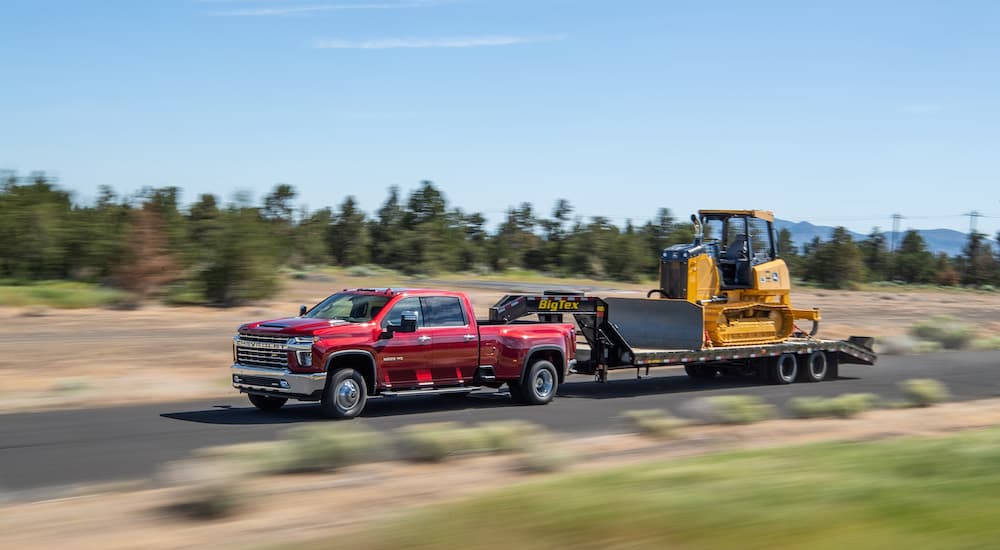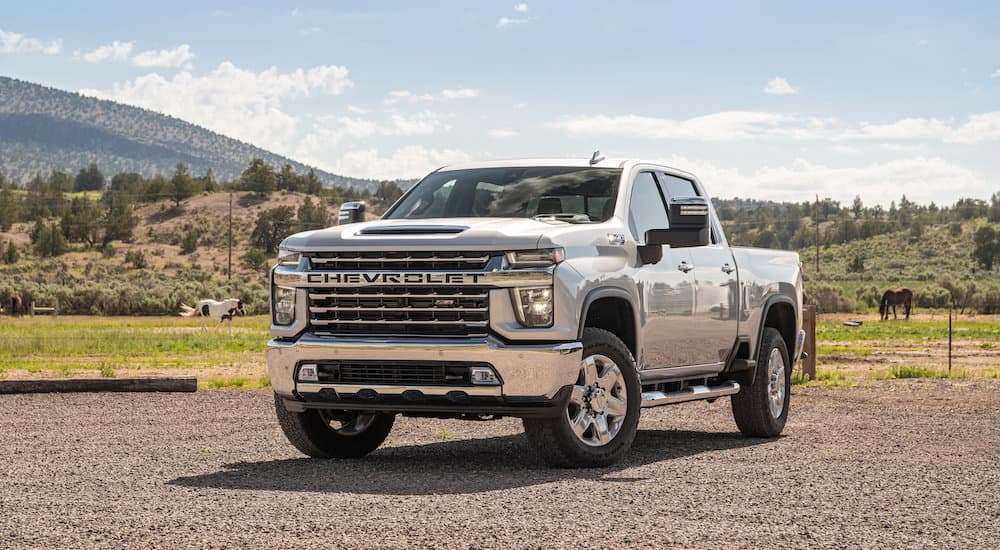Okay, I’ll admit this is a bit of a rhetorical question because, honestly, neither engine is “better” regarding trucks. Ultimately, it depends entirely on what a person wants from their pickup and the overall performance and capability they need. This is one of those “no single option is best for everyone” situations, and the best choice will entirely depend on what someone needs while looking at new or used trucks for sale. I know that’s not the most helpful answer, but I’m not going to leave it at that, don’t worry; instead, we’ll take a good look at what each can offer.
Horsepower
We’ll start things off by looking at horsepower, where a gas engine typically comes out on top when looking at trucks. This can vary, of course, since different engines available from different manufacturers and across various model years will deliver a wide range of horsepower levels. With that disclaimer out of the way, you’ll typically get greater horsepower from a gas engine compared to a similar diesel engine, particularly when looking at a light-duty, full-size pickup.
For example, the 2023 Chevy Silverado has three gas engines and a single diesel offering. The most powerful gas engine is a 6.2L EcoTec3 V8 that delivers 420 hp, while the impressive 3.0L Duramax Turbo-Diesel engine only puts out 305 hp. That’s a pretty huge difference, and while you can certainly find exceptions to this basic rule, you’ll generally see the same thing across models from every manufacturer. This greater horsepower often translates into more robust acceleration when moving, like when you want to pass someone on the highway.

Torque Output
Once again, I’m working with general rules and typical situations, but you’ll typically find the opposite to be true with torque compared to horsepower: diesel engines are the kings of torque. Looking at the two engines for the 2023 Silverado 1500 again, the 6.2L V8 gas engine puts out 460 lb-ft of torque, while the Duramax Turbo-Diesel tops that with 495 lb-ft of torque. That’s not as dramatic a difference as the disparate levels of horsepower, but it’s still noteworthy, and that often translates into greater initial acceleration from a stop or while towing.
The one big caveat I need to put here is that things are changing with new technology and improvements in engine design. For example, looking at the 2020 Ford F-150, the 3.0L Turbo Diesel engine puts out an impressive 440 lb-ft of torque. The 3.5L High-Output EcoBoost Turbo V6 gas engine for the F-150, however, blows that away with 510 lb-ft of torque, plus 200 hp more than the diesel offering. You won’t see this kind of thing if you’re looking at a truck from ten years ago necessarily, but with improvements in engineering, it’s not unheard of today. So, diesel generally gives you more torque, but it’s not an absolute rule, and there are exceptions to watch for.
Towing Capacity
This is an interesting area where more factors are at play than just whether a truck has a diesel or gas engine. Decades ago, you could count on a diesel engine to deliver greater towing capability, but these days it really depends on the situation. Going back to the 2023 Silverado, the diesel engine and 6.2L V8 can handle up to 13,300 lbs of conventional towing. Looking at the 2020 Ford F-150, its diesel engine can haul up to 11,500 lbs, but an available 3.5L EcoBoost Turbo V6 gas engine gives it up to 13,200 lbs of towing capacity.
Where diesels are undeniably the king, however, is where you start looking at bigger, heavy-duty trucks and gooseneck or fifth-wheel towing. For example, the 2023 Chevy Silverado 3500 HD has a standard 6.6L V8 gas engine that can handle up to 17,200 lbs of towing capacity. Its 6.6L Duramax Turbo-Diesel engine can pull up to 36,000 lbs of weight behind it when properly equipped for optimal fifth-wheel towing. That’s more than twice the capacity; this is where diesel engines shine in a way that gas engines simply can’t match.
Payload Capacity
Things get a bit trickier when it comes to payload since all weight on your truck will reduce its maximum payload capacity. A truck has a set Gross Vehicle Weight Rating based on how much weight its frame can support; the weight placed on it will impact how much it can handle. Diesel engines typically weigh more than gas engines, so you will usually have greater payload capacity with a gas engine compared to diesel. For example, the 2020 F-150, with its diesel engine, has up to 2,020 lbs of maximum payload, while the same truck, with its available 3.5L V6 engine, can handle up to 3,230 lbs of payload. That’s a huge difference, and it really speaks to how much more weight a diesel engine brings with it.
Fuel Economy
This is another interesting case where the rules have changed a bit in recent years. The old standard was that diesel engines delivered superior fuel economy for trucks compared to their gas counterparts, but improvements in engineering have closed that gap quite a lot. You’ll still see this in play, don’t get me wrong; for example, let’s look at the 2023 Silverado again:
- 2.7L I-4 Gas Engine: 19 MPG City, 22 MPG Highway, 20 MPG Combined
- 3.0L Turbo-Diesel: 24 MPG City, 29 MPG Highway, 26 MPG Combined
That’s a big difference, especially if you have to do a lot of highway driving to get around where you live or to reach different job sites. But, now let’s look at that 2020 Ford F-150 again:
- 2.7L EcoBoost V6 Gas: 20 MPG City, 26 MPG Highway, 22 MPG Combined
- 3.0L Turbo-Diesel V6: 21 MPG City, 29 MPG Highway, 24 MPG Combined
The difference here is much less substantial, partly due to Ford’s diesel engine having lower city efficiency than Chevy’s. Even with that in mind, the efficiency of Ford’s gas engine is just excellent. Things get even more interesting if you look at the 2023 Ford F-150, which now has an available 3.5L PowerBoost Turbo V6 Hybrid engine that gets an estimated 25 MPG in the city, 25 MPG on the highway, and 25 MPG combined fuel economy. Hybrid engines like this can deliver incredible horsepower and monster torque while also being incredibly efficient. Like I said, the rules have changed.
Maintenance Ease and Costs
Here’s an area where things haven’t changed very much: gas engines are generally easier and less expensive to maintain than their diesel counterparts. The differences in how both engines function create important distinctions in keeping them serviced even with routine things like oil changes. Sure, diesel engines don’t use spark plugs so you don’t have to worry about replacing those, but there’s still plenty of maintenance that needs to be done on them.
Durability and Longevity
Another way the old rules are still in play is when it comes to the longevity of these engines. In general, diesel engines are more durable and last a lot longer than gas engines when looking at trucks. Most people will tell you that a diesel engine is just getting warmed up and is finally broken in at about 100,000 miles; 200 to 300,000 miles isn’t unusual at all for a diesel engine that’s properly maintained. This is very important for anyone shopping for a used truck: for a gas engine, lower mileage is good; for a diesel engine, you typically want higher mileage to ensure it hasn’t just sat in place but has been used and kept in good condition.
To Quote Wise, Animated Spaniards: “Both, Both is Good.”
As you can see, at the end of the day, both types of engines are excellent and offer their own advantages and drawbacks. What someone wants from a truck will guide them in choosing the right engine to meet their requirements and deliver everything they need. The differences between them have changed a bit, and this is very important when looking at new trucks. Plus, innovative technology like hybrid engines and battery-electric engineering is changing everything we know about pickups. All of these rules will be different in another decade, which is why it’s so important to re-examine what’s out there to stay on top of changes in the industry. Personally, I can’t wait to see what the future brings.





